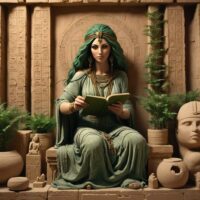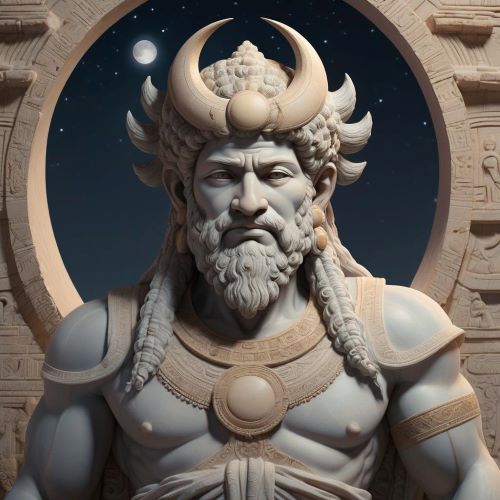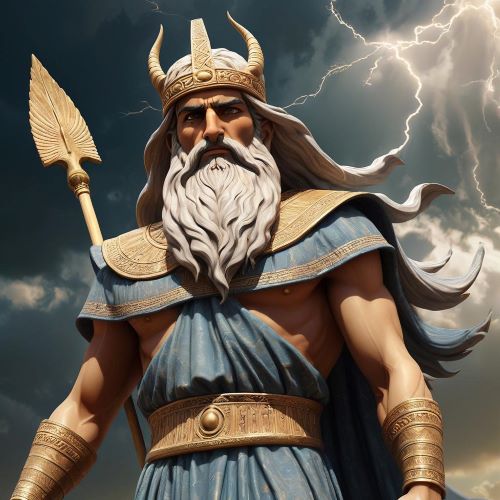Ninimma : Goddess of Scribes
Listen
At a glance
| Description | |
|---|---|
| Origin | Sumerian Mythology |
| Classification | Gods |
| Family Members | Enki (Father), Ninkurra (Mother), Kusibanda (Husband), Uttu (Child) |
| Region | Iraq |
| Associated With | Childbirth, Scribes, Fertility |
Ninimma
Introduction
Ninimma, a deeply venerated deity in Sumerian mythology, stands as a bridge between divine intellect and the generative powers of life. Though not as widely known as Inanna or Ninhursag, she held an integral position within the pantheon, particularly in the sacred city of Nippur. As a scribe of the gods and a midwife of creation, Ninimma was both guardian of knowledge and facilitator of birth. Her name appears in early records like the Fara god list, and her worship spanned centuries, visible in temple offerings and theophoric names from the Ur III to the Kassite period. Through her enduring presence in mythology, temple liturgy, and divine genealogy, Ninimma served as a custodian of both wisdom and life.
In ancient Mesopotamia, she was associated with sanctuaries in cities like Nippur, Adab, and Ur, and maintained cultic significance even into the Achaemenid and Seleucid periods. Her temples bore names that reflected her transformative and intellectual roles, such as Emekilibšudu, “house which perfects all the me,” and Enamengarra, “house which establishes dominion.” Her sacred spaces often neighbored those of Enlil and Ninlil, further emphasizing her status in the divine court. These enduring mentions across different cities and periods highlight the deep reverence Sumerians held for Ninimma, not just as a deity of record-keeping but as a life-giver and teacher.
Physical Traits
While explicit visual depictions of Ninimma are rare in Sumerian art and iconography, her roles offer indirect clues about how she might have been symbolized. Deities closely linked to writing and birth were typically imagined with their respective instruments of power. In Ninimma’s case, she might have been represented with a stylus and tablet, indicative of her scribal functions, or possibly a knife, alluding to her responsibilities in severing the umbilical cord during childbirth. Some scholars suggest she had associations with vegetation, an aspect that may have inspired depictions incorporating plants or green motifs, reflecting fertility and natural cycles.
Her imagined presence would have combined wisdom, nurturing, and ritual purity—core values in Mesopotamian religious life. Whether envisioned in priestly robes or as a healer beside birthing women, Ninimma’s essence was likely conveyed through symbolic rather than literal representation, mirroring the abstract nature of her divine duties.
Family
Ninimma’s parentage varies across traditions, revealing her layered and evolving character. In one version of the myth Enki and Ninhursag, she is portrayed as the daughter of Enki and Ninkurra, linking her to a divine lineage of wisdom and creativity. Other texts, such as the An = Anum god list, alternatively describe her as the daughter of Enlil, positioning her within the central Sumerian divine household. This divergence in genealogical accounts reflects regional and temporal shifts in how her role was understood.
In some hymns and later reinterpretations from Seleucid Uruk, she is counted among the seven children of Enmesharra, suggesting a symbolic association with order and primordial forces. Ninimma’s relationships are similarly complex. She is variably described as the sister or wife of Ninurta, the warrior god, and in another mythic variant, is said to bear a child, Uttu, with Enki. Some traditions even name Kusibanda, the divine goldsmith, as her consort. This fluidity in familial connections highlights her mythological versatility and the shifting roles she played in different cult centers.
Other names
Ninimma’s name in cuneiform is often rendered as SIG7, a reading confirmed through phonetic spellings in Sumerian lexical texts. The second part of her name, SIG7, remains ambiguous, with various scholarly theories suggesting meanings such as “green growth,” “brick,” or a pun involving female reproductive symbolism. Another interpretation posits that her name might mean “lady of the clay tablet,” aligning with her scribal domain and hinting at her intimate connection with both writing and creation.
In certain texts, she has been equated with Zisummu, a deity associated with similar functions in later Mesopotamian religion. She was sometimes confused with Nammu, another creator goddess, likely due to their overlapping roles in the birth and formation of humanity. While Nisaba was more prominently linked with the grain and writing, Ninimma’s literary duties were more connected to record preservation and clerical ritual. Her identity was thus distinct but often intersected with other goddesses involved in creation and knowledge, demonstrating her integrative function within the pantheon.
Powers and Abilities
Ninimma’s powers were multifaceted, reflecting her dual nature as a goddess of both intellect and biological processes. Her oldest known domain was the scribal arts. As a divine record-keeper and scholar, she was entrusted with maintaining the celestial order, preserving divine decrees, and overseeing temple libraries. These attributes made her an essential figure in Mesopotamian bureaucracy and theology, where writing was considered sacred and powerful.
Beyond intellectual realms, Ninimma played a crucial role in birth and creation. In mythological narratives, particularly from the Old Babylonian period, she is one of the divine assistants who helped shape human beings from clay, working alongside other goddesses like Ninmah and Ninšar. She was responsible for cutting the umbilical cord—an act symbolizing the separation of divine essence from mortal life and the beginning of an individual’s earthly fate. This pivotal moment granted her a role in determining destiny, elevating her to a figure of both maternal care and divine judgment.
Her healing abilities also became prominent in later texts, especially during the Middle Babylonian period. She is invoked in incantation series like Šurpu, where her name is called upon to dispel curses and illness. In these rituals, Ninimma represents divine compassion and restoration, aligning her with other goddesses of health such as Gula. A hymn from 2019 highlights her as a divine counselor, offering wisdom to deities like Enki and Inanna, solidifying her role as an adviser in both mortal and cosmic affairs.
Modern Day Influence
Ninimma’s influence may not be immediately visible in contemporary culture, but her legacy quietly endures through her archetypal roles. Modern institutions like libraries and archives reflect her function as a guardian of knowledge. The image of the wise woman—combining intellect with nurturing—is a powerful motif in literature, healthcare, and education, echoing Ninimma’s ancient persona.
Her association with birth has parallels in today’s midwifery and maternal health practices, where the sacredness of childbirth is increasingly recognized. Naming ceremonies and rituals across cultures still carry elements of fate determination, recalling Ninimma’s presence at the threshold of life. Academically, she is a subject of renewed interest in fields like gender studies, archaeology, and mythology, where scholars explore the intersections of feminine divinity, authorship, and creation.
As Sumerian mythology regains attention through popular culture, historical fiction, and digital platforms, Ninimma offers a compelling lens through which to explore the ancient world’s reverence for life, knowledge, and divine order. She reminds us that the keepers of stories and the givers of life share a sacred, often overlooked space in the human imagination—one that endures through centuries and civilizations.
Related Images
Source
Asher-Greve, J. M., & Westenholz, J. G. (2013). Goddesses in Context: On Divine Powers, Roles, Relationships and Gender in Mesopotamian Textual and Visual Sources. ISBN 978-3-7278-1738-0.
Fandom. (n.d.). Nin-imma | Religion Wiki | Fandom. Retrieved July 17, 2025, from https://religion.fandom.com/wiki/Nin-imma
Fandom. (n.d.). Ninimma – JB’s Modes of Knowledge Wiki – Fandom. Retrieved July 17, 2025, from https://jabibbles.fandom.com/wiki/Ninimma
George, A. R. (2005). Review: The God Ninurta in the Mythology and Royal Ideology of Ancient Mesopotamia by Amar Annus. Bulletin of the School of Oriental and African Studies, University of London, 68(2), 307–309.
Krul, J. (2018). The Revival of the Anu Cult and the Nocturnal Fire Ceremony at Late Babylonian Uruk. Brill.
Lambert, W. G. (2013). Babylonian creation myths. Eisenbrauns.
Wikipedia. (2007, March 8). Ninimma – Wikipedia. Retrieved July 17, 2025, from https://en.wikipedia.org/wiki/Ninimma
Wikipedia. (n.d.). Šassūrātu – Wikipedia. Retrieved July 17, 2025, from https://en.wikipedia.org/wiki/%C5%A0ass%C5%ABr%C4%81tu
Frequently Asked Questions
What is lorem Ipsum?
I am text block. Click edit button to change this text. Lorem ipsum dolor sit amet, consectetur adipiscing elit. Ut elit tellus, luctus nec ullamcorper mattis, pulvinar dapibus leo.
What is lorem Ipsum?
I am text block. Click edit button to change this text. Lorem ipsum dolor sit amet, consectetur adipiscing elit. Ut elit tellus, luctus nec ullamcorper mattis, pulvinar dapibus leo.
What is lorem Ipsum?
I am text block. Click edit button to change this text. Lorem ipsum dolor sit amet, consectetur adipiscing elit. Ut elit tellus, luctus nec ullamcorper mattis, pulvinar dapibus leo.
What is lorem Ipsum?
I am text block. Click edit button to change this text. Lorem ipsum dolor sit amet, consectetur adipiscing elit. Ut elit tellus, luctus nec ullamcorper mattis, pulvinar dapibus leo.
What is lorem Ipsum?
I am text block. Click edit button to change this text. Lorem ipsum dolor sit amet, consectetur adipiscing elit. Ut elit tellus, luctus nec ullamcorper mattis, pulvinar dapibus leo.










